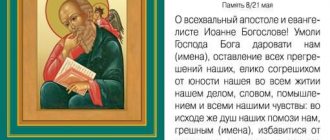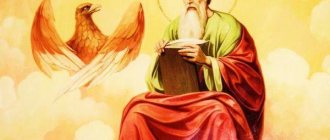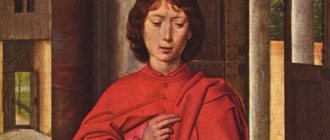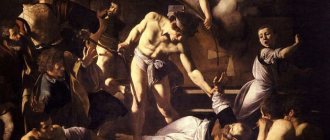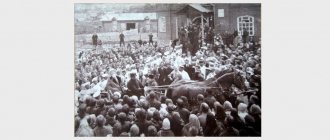honors the memory of the holy, glorious and all-validated Apostle and Evangelist John the Theologian on October 9 (September 26, old style). This day is considered one of the great holidays, numbered among the twelve. The Apostle John occupies a special place among the disciples of Christ. It is no coincidence that the Church calls John the apostle of love, since he taught that without love a person cannot approach the Lord. The Apostle John is the author of the Gospel of John, three cathedral epistles and the Revelation of John the Theologian (Apocalypse). John the Theologian is the only one of the twelve apostles who died a natural death.
The life and sermon of the Apostle and Evangelist John the Theologian
The holy apostle and evangelist John the Theologian was the son of Zebedee and Salome (daughter of the righteous Joseph the Betrothed). John, together with his older brother the Apostle James, who was a fisherman, was called by Jesus Christ to be one of his disciples, this happened on Lake Gennesaret. And they, leaving their father Zebedee, followed the Savior. (Matt. 4:21; Mark 1:19). John was one of the Savior’s favorite disciples. According to the Gospel of Mark, Christ called the brothers James and John “ sons of thunder ” (Boanerges), probably because of their impetuous character. John always followed the Lord. He witnessed the Lord's resurrection of the daughter of the synagogue ruler Jairus (Mark 5:37; Luke 8:51) and witnessed the Transfiguration of the Lord on Mount Tabor (Matthew 17:1; Mark 9:2; Luke 9:28). During the Last Supper, he reclined next to the Lord and, at a sign from the Apostle Peter, leaning against the Savior’s chest, asked about the name of the traitor.
The Apostle John followed Christ when He, bound, was led to the trial of the lawless high priests Annas and Caiaphas; he was also in the bishop's court during the interrogations of the Savior and followed Him along the Way of the Cross. At the foot of the Cross, he grieved together with the Mother of God and heard the words of the Lord addressed to Her: “Woman, behold Thy son,” and to him: “Behold Thy Mother” (John 19, 26, 27). From this period, the Apostle John took care of the Most Holy Theotokos until Her Dormition. After the Dormition of the Mother of God, the Apostle John went with his disciple Prochorus to preach in Ephesus. The ship they were sailing on was wrecked. Everyone except the Apostle John was thrown ashore by the wave. On the fortieth day, a wave washed him ashore. In Ephesus, the apostle's preaching was accompanied by numerous signs, and the number of believers increased significantly.
During the reign of Emperor Nero, John was captured and taken to Rome, where he was given poison to drink, then thrown into a cauldron of boiling oil, but the Lord preserved him. Then the apostle was exiled to Fr. Patmos. During his stay on the island, John converted all the inhabitants to the Christian faith, cast out many demons from idol temples and healed the sick. The sorcerer Kinops especially strongly resisted the preaching of the Apostle John, but with the help of prayer, the power of God’s grace acting through him, John destroyed all the demonic tricks of Kinops, and the proud sorcerer died in the depths of the sea. On about. Patmos Apostle John wrote the book “ Revelation ” (Apocalypse), in which he figuratively announced the secrets of the destinies of the Church and the end of the world. After the end of his exile, the Apostle John returned to Ephesus, where he continued his work on the gospel, teaching Christians to beware of false teachings. Here he wrote the Gospel and three conciliar messages, which speak about the meaning of love for God and neighbors, without which salvation is impossible.
John the Evangelist on Patmos, 17th century, Nizhny Novgorod
It is no coincidence that the Church calls John the apostle of love , since he taught that without love a person cannot approach the Lord. Being already an old man, John learned that one young man had left the true path and became the leader of robbers. The apostle went into the desert in search of him. Seeing John, the young man began to hide from him, but the apostle rushed after him, begging him to stop, promising to take upon himself the young man’s sin, if only he would repent and leave his soul-destroying path. The young man was touched by the kindness and love of the apostle, repented and set about correcting his life.
Library of the Russian Faith Teachings in memory of the Apostle John the Theologian. Great Menaion of Cheti →
Read online in original
JOHN: number of spiritual aspirations “9”
The category of people whose number of spiritual aspirations is nine is characterized by imbalance and inconsistency. Their main desire is to improve the quality of life (both their own and that of others), which they try to bring to life solely in accordance with their own ideas. Nature has endowed the “niners” with a super-strong sense of responsibility and inflated demands on others, and only attachment to loved ones makes them indulgent.
Despite the fact that “nines” are quite ambitious, excessive daydreaming and lack of vital energy do not allow them to reach great heights. Failures can turn such people into grumpy losers who are embittered towards the whole world, but more often than not, “nines” perceive defeat philosophically and continue to look for new ways for development.
“Niners” are attracted to everything beautiful. Distinguished by a heightened sense of harmony, such people always stand out “in the crowd”: with extravagant outfits, unusual activities, artistry
They need everyone's attention like air, while the feeling of uselessness causes bitter resentment. The dream of “nines” is to make everyone around them happy
But most often they fail to do this, because they do not want to go into detail about finding out the essence of happiness for a particular person, and therefore they either remain inactive or do something wrong, subsequently not wanting to admit their mistakes.
People - “nines” constantly live in a world of illusions that they care for and cherish. At the same time, facing the worst manifestations of reality for them is serious stress, causing suffering and even depression. Already in adulthood, “nines” are distinguished by frivolity, impracticality, inability to adapt to life and youthful idealism.
Meanwhile, sometimes they still have common sense and prudence. In a familiar and comfortable environment, “niners” relax, become charming and pleasant interlocutors. Their personal life is very rich, full of emotions and deep experiences. Due to the fact that “nines” are able to subtly sense the desires of others, as well as create a harmonious ensemble of “internal” and “external”, they often become talented designers.
Repose of the Apostle John the Theologian
The Apostle John ended his earthly journey at the age of over one hundred years. He lay down alive in the grave and ordered his disciples to cover him with earth, which they did, grieving for him. Having learned about this, the rest of the apostle’s disciples came to the burial place and dug up the grave, but it turned out to be empty.
Repose of the Apostle John the Theologian. Miniature Minology of Vasily II. Constantinople, 985 Vatican Library. Rome
In the 4th century, a small church was built on the site of the grave of John the Evangelist, and under Emperor Justinian a huge basilica with six domes (each 30 m high) was erected here. Currently, only floor slabs and columns remain from it.
Ruins of the Basilica of the Holy Apostle and Evangelist John the Theologian
Ikos 11
Your luminous soul, having reached the measure of perfect age, has become aware of the approaching time when it is fitting for the corruptible to inherit incorruptibility and for a mortal to inherit the promised immortality. Having ended your earthly life, you commanded your disciples to cover your body to the top with earth; Having heard about this, the brethren in the city came to your tomb and, having dug it up, found nothing in it. Moreover, having realized that your change was not created by an ordinary human death, I hurried to you like this:
Rejoice, O eagle, who renewed your youth by approaching the Sun of the Glory of God; Rejoice, for by such a change you have surpassed all the rules of human nature.
Rejoice, according to the promise of your Good Teacher, you are seated on one of the twelve thrones; Rejoice, do hereby bring justice and righteousness among the people of God Israel.
Rejoice, enjoy the sight of the Sweetest Jesus, you reclined to the Unmanly One before His Passion and Resurrection; Rejoice, intercede for us all good things from His mercy.
Rejoice, John the Apostle, confidant of Christ and the Theologian.
Troparion, Kontakion and Canon to the Holy Apostle and Evangelist John the Theologian
Troparion, tone 2:
The beloved Apostle of Christ God, trying to deliver unrequited people, accepts the bot, falling down, even as he reclines on his chest. Pray to the Theologian for the impending pagan rebuke, as if to disperse a cloud, asking us for peace and great mercy.
Kontakion, voice 2:
Who will confess your greatness as a virgin; You pour forth miracles, and pour out healings, and pray for our souls, as the Theologian and friend of Christ.
Library of the Russian Faith Canon to the Holy Apostle John the Theologian →
Read online
Ikos 9
The prophets of many things will not be able, according to their heritage, to speak your mercy to the fallen, O Saint of God, for having endured many attacks and sorrows from evil people, you have not hardened your heart. Whenever something from them fell into your hand, for you were endowed with bodily strength and great strength from God, you punished with salvation and, repenting, you accepted with love. Remembering your kindness towards those who sin, we cry out to you:
Rejoice, thou who in thy meekness and humility imitated Christ God; Rejoice, conquering the spirit of malice through your kindness.
Rejoice, strong patience adamante; Rejoice, perfect husband image.
Rejoice, unshakable warrior of Christ; Rejoice, you have accepted the Cross of Christ as a weapon of victory.
Rejoice, for with your compassion you satisfy our sorrows and sorrows; Rejoice, for through your prayers repentant sinners are being prepared for the Kingdom of Heaven.
Rejoice, Hieromartyr John, quick helper and warm representative of God.
Holy Apostle and Evangelist John the Theologian. Icons
The Holy Church gave only the holy Apostle John, as the seer of God's destinies, the title of Theologian. The iconographic symbol of the Apostle and Evangelist John is the eagle. Also, the Apostle John is depicted with an Angel who conveys to him the Divine Word. In early Christian art, the Apostle John the Theologian was often depicted as a young man, in particular, as he is depicted in mosaics in Ravenna: in the dome of the Baptistery of the Orthodox (mid-5th century) and in the medallion on the western arch of the Church of San Vitale (546-547).
Apostle John the Theologian. Mosaic from the Church of San Vitale in Ravenna. 546–547
However, there are also the oldest images of the apostle in the form of an old man in the church of San Vitale in Ravenna.
Apostle John the Theologian. Mosaic from the Church of San Vitale in Ravenna. 546–547
In later icons, the Apostle John is depicted as an old man with an inkwell, a pen, a book in his hands and in the presence of an angel or eagle.
Apostle John, 1408, Rev. Andrei Rublev. Fragment of the fresco “The Last Judgment” from the Assumption Cathedral in Vladimir
Apostle John. Icon. Rus. XVI century Ryazan
Apostle John with his life. Icon. Rus. Beginning of the 16th century Tretyakov Gallery Moscow
In what cases do they resort to reading the akathist?
An akathist is a song of praise and at the same time a prayer request. The Akathist to John the Theologian should be read privately when a believer wants to pay tribute to this saint, both in his days of joy and in his days of sorrow.
John the Evangelist is considered the patron saint of fishermen, writers, publishing workers and the paper industry.
In addition to people of these professions, the sick, women who have not found happiness in marriage, and all disadvantaged people resort to reading the akathist: beggars, orphans, old people left alone.
Throughout his life, John the Theologian was engaged in educational activities, gaining considerable fame in the field of spiritual literature. Therefore, students often resort to him for help: students and schoolchildren with a request to successfully pass exams or sessions.
We advise you to study Prayer so that everything works out in life
In the church, the akathist is read during services on the days of remembrance of the saint.
Everything that John did (prayed, wrote books, preached, healed) was marked by the sign of the highest love for his neighbor and God. The saint generously shared this feeling with those around him. Now through prayer to the saint we can feel this love. The main thing is that the words of the prayer come from a pure heart and are pronounced with sincere faith.
Temples and monasteries in the name of John the Theologian in Rus'
In the name of the Apostle and Evangelist John the Theologian, the church on Varyazhki in Smolensk . The church was built in the 1160s and is a cross-domed single-domed building. The facade of the church is divided into three parts, each of which has windows. There is a portal on the eastern side of the facade. The building is crowned with a helmet-shaped head with a massive octagonal drum. At the top there is a small bulbous head. In the post-revolutionary years, the temple was closed and looted. Heavily damaged during the battles for the city in 1941-1943: the bell tower, refectory and chapel were completely destroyed. The temple was transferred to the local diocese of the Russian Orthodox Church in 1993. In 1994-1995, restoration work was carried out in the interior of the temple, and an iconostasis was installed.
Church of St. John the Evangelist on Varyazhki. Smolensk
In the name of the Apostle and Evangelist John the Theologian, the church from Misharina Mountain in Pskov . The church dates from 1547. The temple is placed on a basement with four pillars and three semicircular apses. In the decoration of the facades with lobed arches and apses with roller patterns, curbs and runners, a new detail appears: a cross without a roller, laid out around the window of the central apse. The church is active.
Church in the name of the Apostle and Evangelist John the Theologian on Misharina Mountain. Pskov
In the name of the holy apostle and evangelist John the Theologian, the Cathedral of the St. John the Theologian Savvo-Krypetsky Monastery in the village of Kripetskoye-1, Pskov region, . The cathedral church in the name of the Apostle John the Theologian was consecrated in 1557. The cathedral is stone, four-pillared, single-domed, on a high basement. At the beginning of the 20th century, the cathedral was reconstructed. In 1922, all valuables were removed from the monastery and the cathedral. Divine services in the cathedral ceased in 1923. In the 1950s in the basement of the temple there was a barnyard and a stable. In 1995, the Krypetsky Monastery became active again.
Krypetsky St. John the Theologian Monastery in the Pskov region
In the name of the holy apostle and evangelist John the Theologian, the Cherdyn St. John the Theologian Monastery in the city of Cherdyn, Perm Territory, was consecrated . St. John the Theologian Monastery was founded by Saint Jonah, Bishop of Perm, in 1462-1463. In 1718, a new stone two-altar church was built in the monastery. In 1764, Catherine II carried out a church reform, as a result of which many monasteries and churches were closed; the St. John the Theologian Monastery was left to its own maintenance, as a result of which it fell into complete decline and was closed in 1784. With the beginning of the revolutionary unrest in 1917, the monastery was persecuted by atheists. In 2004, the Cherdynsky Monastery was reopened as a men's monastery.
Church of St. John the Theologian of the Cherdyn St. John the Theologian Monastery
In 1478, the Cheremenets St. John the Theologian Monastery was founded, located on a peninsula on Lake Cheremenets in the Luga district of the Leningrad region in the town of Cheremenets, Skreblovsky rural settlement . The first mention of the monastery dates back to 1498. According to legend, during the reign of John III (1440-1505) in 1478, on the island where the monastery is located, an icon of the holy apostle and evangelist John the Theologian appeared to the peasant Mokiy. The prince, having learned about this phenomenon, ordered to found a monastery on the island in the name of the apostle.
Cheremenetsky St. John the Theologian Monastery. Early 20th century photography
In the name of the holy apostle and evangelist John the Theologian, the oldest wooden church in the city of Pereyaslavl-Khmelnitsky, Ukraine, . The construction dates back to 1606. It is a three-domed building with chapters arranged in one row. The logs of the vestibule and nave are rectangular in shape, the altar is faceted, built on five sides of an octagon. The church was transported from the village of Ostroiki and is located on the territory of the Museum of Folk Architecture and Life. In Soviet times, it housed a museum of atheism, and now it is a museum of the UOC.
Church of St. John the Evangelist in Pereyaslavl-Khmelnitsky, Ukraine
In the name of the holy apostle and evangelist John the Theologian, the chapel of the cathedral in honor of the Epiphany of the Lord of the Avraamiev Epiphany Monastery in Rostov the Great, Yaroslavl region . The monastery was founded in 1261. The cathedral was built between 1553 and 1554. and is a three-aisle, five-domed, cross-domed, four-pillar, three-apse temple. During the Time of Troubles, the Avraamiev Monastery was plundered by the Poles. In the middle of the 17th century, under Archimandrite Jonah, the stone Vvedenskaya and Gate St. Nicholas churches were erected. In the XX-XXI centuries. The Avraamiev Monastery has undergone poor quality restoration. Currently, the condition of the monastery is unsatisfactory.
Avraamiev Monastery in Rostov the Great
In the name of the holy apostle and evangelist John the Theologian, the chapel of the cathedral in honor of the Annunciation of the Most Holy Theotokos of the Murom Annunciation Monastery in the city of Murom, Vladimir Region . The first wooden church in the name of the Annunciation of the Blessed Virgin Mary was erected in Murom in 1192. In 1553, construction of the Annunciation Monastery began on the site of the church. In 1612-1616, the monastery was badly damaged by fires, in addition, it was plundered by the Poles, but the monastery’s prosperity was soon restored, and the Annunciation Church, according to the inventory of 1637, “after being devastated by the Poles, was renewed by the abbot.” The high cube of the main volume of the temple is covered with a closed vault, which is decorated with two rows of kokoshniks. The third row is visually formed by kokoshniks at the base of the drums of each of the five chapters. The main element of modest decor is window trim. The drums of the five domes of the cathedral are very carefully decorated.
Cathedral in honor of the Annunciation of the Blessed Virgin Mary of the Murom Annunciation Monastery
In the name of the holy apostle and evangelist John the Theologian, the chapel of the Church of St. Basil the Great on Gorka in Pskov . The stone building of the Church of Vasily on Gorka was built in 1413 on the site of a wooden building built in 1377. During the Soviet years the church was closed. The building was heavily damaged during the Second World War. From 1945 to 1998, the State Archive (document repository) of the Pskov region was located in the church building. Reconstruction began in 1998, but the church building was severely damaged during a fire in 2003. The temple building was transferred to the Russian Orthodox Church community in 2003.
Church of St. Basil the Great on Gorka in Pskov
In the name of the holy Apostle and Evangelist John the Theologian, the chapel of the Church of St. Nicholas of Usokha in Pskov . The church was first built in 1371, and in 1536, after a fire, it was rebuilt. A large, single-domed, three-apse stone church with a northern pillarless aisle in the name of the Presentation of the Lord; on the south side there may have been a warm chapel in the name of John the Evangelist; both aisles had porches. The vestibules - the main one, western, and the side ones - northern and southern - were connected by a gallery. However, alterations of the 17th–19th centuries. significantly distorted the appearance of the temple.
Church of St. Nicholas of Usokha in Pskov
In the name of the holy Apostle and Evangelist John the Theologian, churches in Georgia were consecrated (approximately 1577), in the village. Margarites of Greece (between 1450 and 1500) and in Ohrid Macedonia (between 1270 and 1280).
Old Believer churches in the name of John the Theologian
In the Old Believers, there are currently several churches in the name of the Apostle and Evangelist John the Theologian. In the Russian Orthodox Old Believer Church today the throne is in the city of Veliky Novgorod and in the city of Naberezhnye Chelny (Tatarstan region), as well as in the village of Staraya Nekrasovka, Odessa region; in the Russian Ancient Orthodox Church - in the village of Tonkino, Nizhny Novgorod region.
Temple of the Apostle John the Theologian. Old Nekrasovka
Temple of the Apostle John the Theologian. Tonkino
The image of the Apostle and Evangelist John the Theologian in painting
Among the artists who depicted the apostle and evangelist John the Evangelist, world-famous painters are: El Greco “John the Evangelist” (1595-1605. Prado Museum, Madrid); Hieronymus Bosch “St. John on Patmos” (1504-1505, Berlin Art Gallery, Berlin), “Scenes of the Passion of Christ and a Pelican with Chicks (Reverse side of the board “St. John on Patmos”; Hans Memling “Apostle John” (c. . 1468); Domenichino “St. John the Evangelist” and others.
El Greco "John the Evangelist", 1595-1605. Prado Museum, Madrid
Hieronymus Bosch "Saint John on Patmos", 1504-1505, Berlin Art Gallery, Berlin
